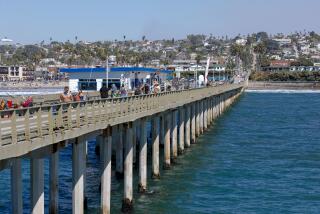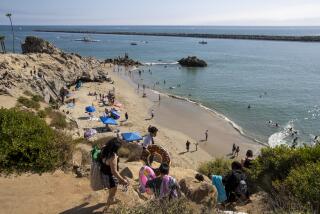Sea wall stops, yet makes, waves
Decades ago, Long Beach was something of a surfing mecca, with wave-pounding beaches where legends like Duke Kahanamoku held the first national surf contest in 1938.
About nine miles of solid rock changed that.
The breakwater, a 50-foot-high wall of rock built by the Army Corps of Engineers in the 1940s, stopped the waves. And by creating a protective barrier, the wall allowed the Port of Long Beach and surrounding marinas to expand and thrive.
For generations, surfers and environmentalists have sought to “break the breakwater” and bring waves back to the Long Beach coast.
That’s still a distant dream. But the City Council is expected to decide whether to fund a study on reconfiguring the roughly two-mile peninsula area breakwater, which lies at the east end of the city away from the huge port complex.
The study, which could cost up to $100,000, will look at the feasibility of removing a portion of the rock wall and the effect that would have on the pricey homes along the Long Beach peninsula, where residents have long seen the breakwater as protection against storms and flooding.
Environmentalists argue the breakwater bottles up urban pollution from the Los Angeles and San Gabriel rivers, creating some of the worst beach water quality in Southern California.
“Most people go to Long Beach, see what it is and go to Huntington Beach or someplace else,” said Seamus Innes, 38, a coastal engineer and member of the Surfrider Foundation. Innes has been surfing for more than 25 years, but he rarely tries to do so in Long Beach. “I was able to see some waves in April, but I was at lunch from work.”
Opposition is already forming from residents of Belmont Shore, Naples and the peninsula, who worry their homes would be flooded by heavy storms if left without the breakwater’s protection. Even with the breakwater, some residents of the peninsula say their homes experience a heavy bashing when it rains.
“I experienced the problems when we’ve had heavy wave action, and I watched the alleys and streets get flooded in my district,” said Frank Colonna, a former council member and resident of the city’s peninsula area. Colonna was also the lone vote against approving the study two years ago.
Colonna said he was skeptical about the environmental benefits of reworking the breakwater. Though such a move might increase water circulation, it could also serve to circulate and dilute existing pollution.
“You have to be careful of what you are wishing for,” Colonna said, “because the outcome could be significantly different from what you expect.”
Through the 1930s, the coast of Long Beach was fully exposed to the ocean’s wrath -- and that became a calling card. Hotels, ornate apartment towers and the Pike amusement park were built around the beaches, making the city a top tourist spot and location for surf competitions.
But slowly, the rock wall about 2 1/2 miles off the coast began going up to protect against storms and safely house the Navy’s Pacific Fleet, which anchored within the breakwater until the mid-1990s.
The breakwater, which took about 50 years to complete, is composed of three segments. About two miles of it lie in front of the Long Beach peninsula, and the rock itself was brought over from Santa Catalina Island, said Long Beach port spokesman Art Wong.
The Long Beach port is tucked behind the wall of rock -- 200 feet wide at its base and 20 feet wide at its top.
The breakwater “provides a safe harbor for ships here, and without it I don’t know if they could have built this complex,” Wong said. “It allowed them to build this land out in the water, and it protects the ships so they’re not being jostled around” while they unload. The Harbor Commission has not taken a position on the issue, he said.
Surfers launched their “Sink the Breakwater” campaign more than a decade ago, pointing out that many big surfing competitions take place only a few miles south in Huntington Beach, labeling itself “Surf City.”
“I think it’s time for the city to take a step forward and get the answers,” said Councilwoman Rae Gabelich, who is helping push the measure. “Is it possible for us to do this? Will it damage any of the homes? ... Is it a mistake or will it be advantageous to the city of Long Beach to be the draw we said we wanted to be for the tourist industry?”
Two years ago, the council approved a study, by an 8-1 vote, to look at the breakwater’s role and the ramifications of removing it. But the study stalled because of a lack of funding.
This time, council members and activists blame Rep. Dana Rohrabacher (R-Huntington Beach) for being unwilling to secure federal funding for the study. But Rohrabacher, whose district includes Long Beach, said he told the council to reorder its priorities for federal funding and place the breakwater at the top of its list.
“I’ve never opposed it,” Rohrabacher said. “Everybody supports asking to get something for nothing.... They have to set the priorities.”
Even if the funding for the initial study by the corps is approved tonight, nearly everyone agrees that the process would take years to complete.
“I still have another 40 years of surfing in me,” Innes said. “So I think it could be done in my lifetime. But it might not be standing-up surfing, I might be boogying.”
More to Read
Sign up for Essential California
The most important California stories and recommendations in your inbox every morning.
You may occasionally receive promotional content from the Los Angeles Times.










